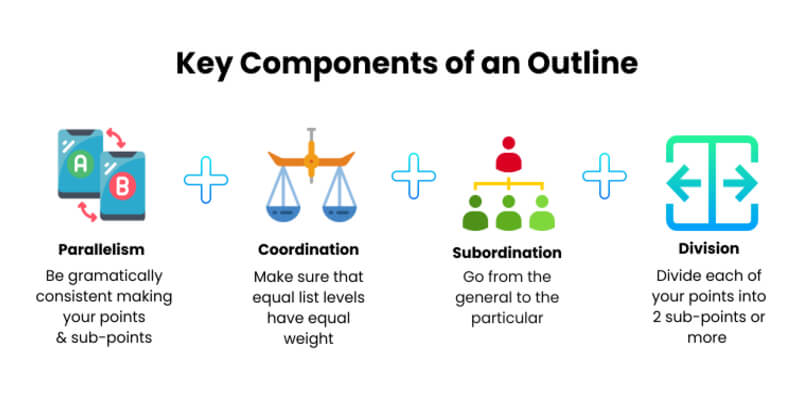An outline is a structured plan that organizes a writer’s ideas and arguments before they start working on their text. It logically arranges the points, examples, and evidence, ensuring a smooth flow and clarity for readers. Outlining as a preparatory step is equally beneficial for essays, reports, presentations, and even larger projects.
There are three main types of outlines:
- An alphanumeric outline uses Roman numerals, capital letters, Arabic numerals, and lowercase letters to organize information hierarchically.
- A decimal outline resembles an alphanumeric outline but uses a numbering system to show relationships between points.
- A full-sentence outline uses complete sentences as entries, providing more information.
This article, crafted by Custom Writing experts, breaks down the key components of a good outline, explains the three outline types, and contains an alphanumeric outline example to guide you in crafting your own.
🗝️ A Good Outline & Its Key Components
It is hard to underestimate the importance of an outline in the process of writing an academic paper. It arranges your thoughts, arguments, and hypothesis to avoid unnecessary gaps, inconsistencies, and lack of logic. The three types of outline format are:
- alphanumeric
- decimal
- full-sentence
All of them can be equally efficient, being adequately selected according to the purpose.
The decimal format numbers the structural paragraphs with 1.1., 1.2., 1.2.1., etc. The alphanumeric outline is generally the same, but the list levels are numbered in Roman numerals, capital letters, Arabic numbers, and lowercase letters. These two formats use short notes rather than full sentences. On the contrary, the full-sentence form can use any of the above numerations, but the paragraphs are written as complete sentences. You’ll find more information about the three outline formats in the below sections.

If your research paper outline is assessed, language and structure shall be your primary concern. The following tips can help you fulfill the assignment correctly.
Parallelism: Grammatical Consistency
A point and its sub-points should have similar grammatical structures. If paragraph 1 starts with a verb, make all its subpoints (1.1., 1.2…) also start with verbs.
Example:
1.1. Visit college websites and evaluate them.
1.1.1. Look for compelling courses.
1.1.2. Note the demonstrative statistics.
Coordination: Equal Weight of Equal List Levels
The subheadings you choose should be of the same importance as all the other subheadings of the same level.
Example:
A. Write your personal statement.
1. Describe your role model.
2. Explain a challenging event in your life.
B. Revise your personal statement.
Subordination: From the General to the Particular
General points shall be separated from the specific ones. The first headings shall be the most general, and each next sub-heading shall become more particular.
Example:
II. Frederic Douglas as a Lecturer.
A. Early lectures and the speech before Garrison.
a. The success of the first speech.
Division: Informational Breakdown
Keep in mind that the outline is not the ultimate purpose. It is only the preparation for the writing. There is no exact number of subpoints you can include, but remember that you will have to arrange them into paragraphs. The only rule is that there should be two or more sub-points on each level. In order to better determine the crucial parts, try a text shortener on a draft that you might have.
📐 Outlining: the Main Rules
Example:
- A clear and precise organizational system is essential. The topics should be subdivided by numbers and letters, followed by a period.
- Every section (heading/subheading) should consist of at least two entries. For example:
- If your outline starts with a section under Roman numeral I, it must also include a section labeled Roman numeral II.
- Suppose you have a capital letter A under category I. In that case, there must follow a capital letter B. Then continue with capital letters C, D, E, and so on, depending on how much information you are going to cover.
- The major points in the outline correspond to your key ideas, which will be placed in each paragraph’s topic sentence.
- The first Roman numeral is for the introduction.
- The next one is for the first body paragraph.
- The third one is for the second body paragraph. (Use as many body paragraphs as you need to fully support your thesis.)
- The last one is for your conclusion.
📑 Outline Formats (with Examples)
Alphanumeric Outline
The alphanumeric outline format is the one most commonly used. It features:
- Roman numerals
- Capitalized letters
- Arabic numerals
- Lowercase letters
For even further subdivisions, you can use Arabic numerals inside parentheses and then lowercase letters inside parentheses. Writing an alphanumeric outline, make short notes, not full sentences.
Alphanumeric Outline Example
Example:
PAPER TITLE
I. INTRODUCTION
II. BODY
A. Paragraph 1
1. Point 1
a. Sub-point 1
b. …
Decimal Outline
The decimal outline format is similar to the alphanumeric one. The difference is the numbering system it uses (1, 1.1, 1.2, etc.). Just like in the alphanumeric outline, the text is written in the form of short notes.
Decimal Outline Example
Example:
PAPER TITLE
1. INTRODUCTION
2. BODY
1.1 Paragraph 1
1.1.1 Point 1
1.1.2 Point 2
1.1.3 …
Full-Sentence Outline
The full-sentence outline format is similar to the alphanumeric one. The difference is that the points are given as complete sentences, not as short notes. A sentence outline gives you the opportunity to specify details directly in the headings rather than creating a long, confusing outline consisting of many brief phrases.
Full-sentence Outline Example
Example:
PAPER TITLE
I. Paper introduction and the thesis statement
II. Paper body
A. First paragraph of the paper
1. First point of evidence that supports the thesis
a. Sub-point that discusses the point A
b. …
References
- Outlining – Harvard College Writing Center – Harvard University
- Types of Outlines // Purdue Writing Lab
- Outlines for Every Type of Writing Composition – ThoughtCo
- Making an Outline – Organizing Your Social Sciences (USC)
- Guidelines for Outlining — Hunter College
- The Writing Center | Outlining | Guides
- Reverse Outline – UNC Writing Center
- Outline Construction – University of Oklahoma
- The Work of Writing by David Galbraith & Veerle M. Baaijen | Taylor & Francis



![Best Descriptive Essays: Examples & How-to Guide [+ Tips]](https://custom-writing.org/blog/wp-content/uploads/2021/01/pencil-notebook-white-background-284x153.jpg)






![Short Story Analysis: How to Write It Step by Step [New]](https://custom-writing.org/blog/wp-content/uploads/2020/12/man-sits-end-trolltunga-before-mountains-284x153.jpg)
